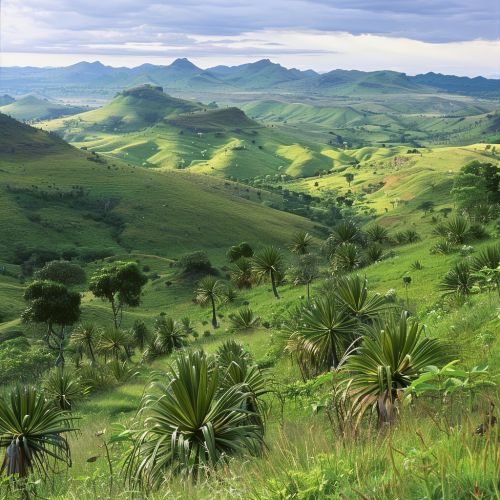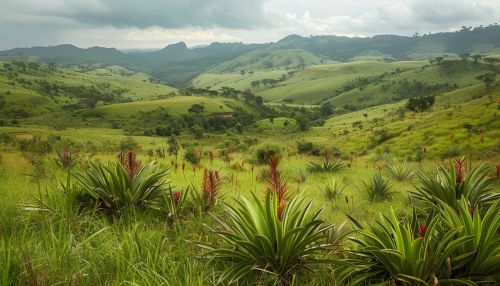Madagascar
Geography


Madagascar, an island nation located in the Indian Ocean off the southeastern coast of Africa, is the fourth largest island in the world. It is situated approximately 400 kilometers (250 miles) east of Mozambique. The island is characterized by its diverse geography, which includes coastal plains, high plateaus, and mountain ranges. The highest peak is Maromokotro, which rises to an elevation of 2,876 meters (9,436 feet) in the Tsaratanana Massif in the northern part of the island.
The island’s geography is divided into five main regions: the east coast, the central highlands, the west coast, the southwest, and the north. Each region has distinct climatic and ecological characteristics. The east coast is known for its tropical rainforest climate, while the central highlands have a more temperate climate. The west coast experiences a dry tropical climate, and the southwest is arid. The northern region is mountainous and features a mix of tropical and temperate climates.
Geology
Madagascar's geological history is complex and dates back to the Precambrian era. The island was once part of the supercontinent Gondwana, which began to break apart around 160 million years ago. Madagascar separated from the Indian subcontinent approximately 88 million years ago, leading to its current position in the Indian Ocean. The island's geology is characterized by ancient Precambrian rocks, including gneisses, schists, and granites, as well as younger sedimentary formations.
The island is also known for its rich deposits of minerals, including chromite, graphite, and mica. Madagascar is one of the world's leading producers of sapphires and is also known for its deposits of other precious and semi-precious stones, such as rubies, emeralds, and tourmalines.
Climate
Madagascar's climate is highly variable and influenced by its diverse topography. The island experiences a tropical climate along the coast, a temperate climate in the highlands, and an arid climate in the southwest. The east coast receives the most rainfall, with an average annual precipitation of over 3,000 millimeters (118 inches). The central highlands receive moderate rainfall, while the west coast and southwest are much drier, with some areas receiving less than 500 millimeters (20 inches) of rain annually.
The island is also subject to tropical cyclones, which can cause significant damage to infrastructure and agriculture. The cyclone season typically runs from November to April, with the most intense storms occurring between January and March.
Biodiversity
Madagascar is renowned for its unique biodiversity, with a high percentage of endemic species. Approximately 90% of the plant and animal species found on the island are endemic, meaning they are found nowhere else on Earth. This high level of endemism is a result of the island's long isolation from other landmasses.
The island is home to a wide variety of ecosystems, including tropical rainforests, dry deciduous forests, spiny forests, and mangrove swamps. Some of the most notable endemic species include the lemurs, a group of primates that are found only in Madagascar. There are over 100 species and subspecies of lemurs, ranging from the tiny mouse lemur to the large indri.
Madagascar is also home to a diverse array of reptiles, amphibians, birds, and invertebrates. The island's flora is equally diverse, with over 12,000 species of plants, many of which are used for traditional medicine and other purposes.
Conservation
Madagascar's unique biodiversity is under significant threat from human activities, including deforestation, habitat destruction, and hunting. The island has lost a significant portion of its original forest cover, and many species are now endangered or critically endangered.
Efforts to conserve Madagascar's biodiversity include the establishment of protected areas, such as national parks and nature reserves. The island has over 50 protected areas, covering approximately 10% of its land area. Some of the most notable protected areas include Andasibe-Mantadia National Park, Ranomafana National Park, and Masoala National Park.
In addition to protected areas, conservation efforts also focus on community-based conservation programs, which involve local communities in the management and protection of natural resources. These programs aim to promote sustainable land use practices and reduce the pressure on natural habitats.
Economy
Madagascar's economy is primarily based on agriculture, mining, and tourism. The island is one of the world's leading producers of vanilla, cloves, and ylang-ylang. Other important agricultural products include coffee, cocoa, rice, and cassava. The fishing industry is also significant, with exports of shrimp and other seafood products contributing to the economy.
The mining sector is a major contributor to the economy, with significant deposits of chromite, graphite, and ilmenite. The island is also known for its gemstones, particularly sapphires, which are mined in the southern part of the island.
Tourism is an important and growing sector of the economy, with visitors attracted to Madagascar's unique wildlife, stunning landscapes, and rich cultural heritage. The island's national parks and nature reserves are popular destinations for eco-tourism.
Culture
Madagascar has a rich and diverse cultural heritage, influenced by its history and the various ethnic groups that inhabit the island. The Malagasy people are the largest ethnic group, and they are divided into 18 sub-groups, each with its own distinct customs and traditions.
The island's culture is a blend of African, Asian, and European influences, reflecting its history as a crossroads of trade and migration. Traditional Malagasy music, dance, and art are important aspects of the island's cultural identity. The island is also known for its unique architectural styles, including the traditional wooden houses of the highlands and the stilt houses of the coastal regions.
The Malagasy language is the official language of Madagascar, along with French. Malagasy is an Austronesian language, closely related to the languages spoken in Indonesia and the Philippines. French is widely spoken, particularly in urban areas and in the business and government sectors.
History
Madagascar's history is marked by waves of migration and the influence of various cultures. The island was first settled by Austronesian-speaking people from Southeast Asia around 1,500 to 2,000 years ago. These early settlers brought with them their agricultural practices, including the cultivation of rice and the domestication of zebu cattle.
Over the centuries, Madagascar became a melting pot of cultures, with Bantu-speaking people from East Africa, Arab traders, and later European colonizers all leaving their mark on the island. The Merina kingdom, based in the central highlands, emerged as the dominant political power in the 19th century, unifying much of the island under its rule.
In 1896, Madagascar became a French colony, and it remained under French control until gaining independence in 1960. The post-independence period has been marked by political instability, economic challenges, and efforts to build a stable and prosperous nation.
See Also
- Indian Ocean
- Endemism
- Gondwana
- Tropical Cyclone
- Vanilla
- Eco-tourism
- Austronesian languages
- Merina Kingdom
- French Colonial Empire
